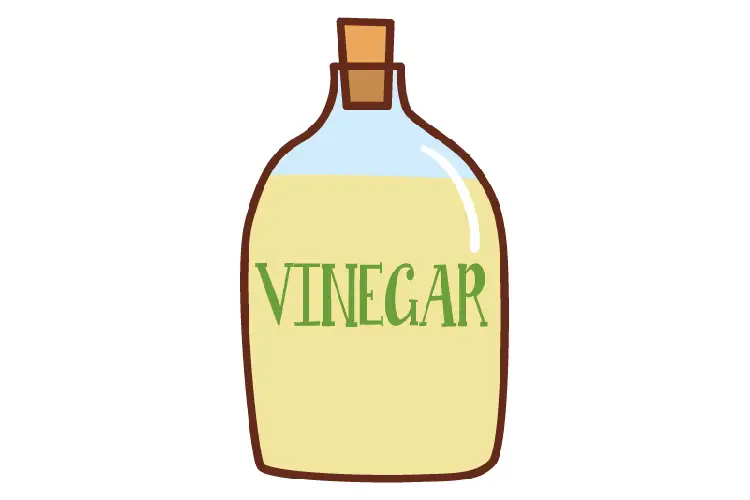While vinegar is a standard household cleaning solution, you may be wondering whether it’s safe on car paint or not. From my experience, vinegar will strip car paint if misapplied.
In this article, you will know more about vinegar, what to do if your car was stripped by vinegar and what other liquids can damage your car paint.
Is Vinegar Safe on Car Paint?
No, vinegar is not safe to use on car paint. It is an acidic substance that can damage the paint and finish on your car. If you must clean your car with vinegar, rinse it off thoroughly and dry the area to prevent further damage. Moreover, vinegar will remove car wax, so you may need to re-wax your car after cleaning it with vinegar.
How to use vinegar to clean the car’s exterior?
Distilled white vinegar is safe to use on car paint. When used in small amounts, it will not damage your car’s paint or clear coat. You can use it to remove water spots, bugs, tar, and tree sap from your car’s surface. Just be sure to dilute the vinegar with water before using it on your vehicle.
Step 1: Mix equal parts of water and vinegar in a bucket.
Step 2: Wet a sponge or washcloth in the mixture and use it to wipe down your car’s surface. Avoid scrubbing too hard, as this could damage the paint.
Step 3: Wipe down the entire surface, wash with soap water and rinse your car off with clean water.
Step 4: Dry your car with a clean towel to prevent water spots from forming.
What To Do If My Car Was Stripped by Vinegar?
Well, if you’ve been using vinegar and have discovered etch spots or dimples, don’t beat yourself too much. You can correct this kind of damage by polishing or painting. Polishing is much easier at home. You will need the best liquid rubbing compound, car polish you can’t get your hands on, and a machine polisher.
What You’ll Need
| Image | Name | Price |
|---|---|---|
 |
Buffing Pad | Check Price |
 |
Dual Action Polisher | Check Price |
 |
Rubbing Compound | Check Price |
 |
Car Polish | Check Price |
 |
Car Wax | Check Price |
Step-by-Step Guide
Step 1: Clean your car thoroughly with car shampoo and rinse with lots of cool water. It’s essential to ensure that you remove all surface dirt. Then park your car in the shade to let the exterior cool down.
Step 2: Buff the affected area. The rubbing compound is a cutting agent which can cut through paint, so be gentle. By this, I mean working in small circular motions for a few seconds until the compound creates a shiny surface.
Step 3: Wipe off any excess compound and move on to the polishing/buffing pad and car polish.
Step 4: Apply a tiny amount of polish on the pad and work the buffer in circular motions. The polish will remove any swirl marks and produce a glossy layer.
Step 5: After polishing the affected area, finish it off with the automotive wax. Note that polishing introduces microscopic pores that’s why you need the wax to seal the surface.
Vinegar Alternatives
Use a clay bar or auto detailing products as an alternative to vinegar. You can find these products at your local auto parts store or buy one of them below:

Meguiar’s G10240 Clay Kit

Chemical Guys Clay Kit

Mothers 07240 California Gold Clay Bar
Besides Vinegar, What Liquids Damage Car Paint?
There are many vehicle paint enemies, which will surprise you. Here are some of the liquids that can damage car paint.
Coffee and soda: These drinks are acidic and can harm your car’s paint. They eat away at the protective layer, plus the sugar leaves a sticky residue. Wash your vehicle as soon as possible after a coffee or soda spill.
Egg: Eggs are often used as a prank. When eggs meet car paint, they can remove an entire layer. Again, it would be best to clean the area with car shampoo and water to remove the egg altogether.
Acetone: This is the main chemical in nail polish remover. If it were to spill on your vehicle, it could eat the paint down to the base within a few hours. Since it’s very corrosive, you should immediately use lots of soapy water to wash the acetone.
Brake Fluid: This vehicle fluid acts as a paint thinner, and it will soften the paint and make it easy to chip and lift from the vehicle’s surface.
Shaving Cream: Another prank favorite will corrode paint if not washed away. If it dries on the car paint, you may retouch it.
Rubbing Alcohol: This chemical is similar to vinegar in that it will damage your car’s paint when used without diluting it.
All-Purpose Cleaners: Most household, all-purpose cleaners are abrasive. While they may be good grease cleaners, they can scratch paint when you rub the cleanser.
Final Thought
As you’ve seen, vinegar can damage car paint when you leave it on for a long time or use it in high heat or direct sunlight. As such, it’s best to take proper precautions to prevent any etching that may occur after its use.
Still, you can use vinegar for other purposes to remove grime, fouls smells and even prevent ice formation.

Leave a Reply